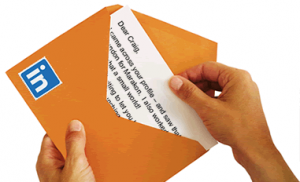The single best way to generate B2B leads on a shoestring budget
InMail: your best Lead Generation bet
Just imagine: you have a tiny budget to grow your (B2B) Business. How do you spend your scarce, hard-earned marketing money to get into accounts and close these new crucial deals that will make your business soar?
My recommendation is a direct and ‘warm’ approach via LinkedIn’s ‘InMail’ feature.
If you’re not familiar with LinkedIn’s InMail feature, you can find out more about it here. The lowdown: LinkedIn sells InMail messages, which you can send to any LinkedIn member*. Before you sign up for this and start shooting messages: here is some advice to boost the response rate of your InMails to the 10% – 20% range.
Step 1 – Scouting
One of InMail’s neat features – if you think about it – is that it is a paid e-mail. Sending an InMail costs approximately €1**. The good news: this keeps the spammers away from your intended audience. The cost of the InMail makes undifferentiated mass-messaging extremely un-economical. The downside: the onus to select the right recipients is on the sender, as each message carries a (virtual) €1 stamp. This is why ‘scouting’ (finding the recipients for your InMail campaing) is so important. Here are the 2 first ground rules:
- Contact only LinkedIn Members with whom you share another LinkedIn contact or a Group Membership – recipients are vastly more likely to respond to someone with whom they have a connection or a Group in common.
- Only approach LinkedIn Members who are open to ‘Deal Making Contacts’ (under ‘interests’, in the LinkedIn Profile) – this is the closest there is on LinkedIn to an ‘opt-in’ permission. Not everybody appreciates an InMail message, so be respectful of someone interestes.
Beyond this, it is up to your creativity and imagination to find the lucky ones who will receive a message from your good self. LinkedIn allows you to select on criteria ranging from geography, industry, function, seniority, company name, and so forth and so on. My recommendation is to define searches that yield 100 – 200 results. For example, if you’re offering a private cloud computing solution and you have good reference customers in the financial services industry looking for propsects in the Boston area – perhaps prior to planning a sales trip to the area in a couple of weeks – your search criteria might be:
- Location: within a 50-Mile Radius of ZIP code 02115 (Boston)
- Industries: Banking and Financial Services
- Function***: Information Technology
- Seniority Level: Director, VP, Manager, Senior
- Years of Experience: 5+ years
Run this search, weed out the results, and store the contacts you want to send an InMail in a LinkedIn Folder. It is wise to keep track in a spreadsheet which searches you have ran. Scouting for the right prospects is not an exact science, but rather a trial-and-error process, with lots of tweaking. You will get better over time and develop an instinct for searches that deliver the best results.
Step 2 – messaging
Your InMail should be sincere & modest: ask for assistance in something small. You can ask, for example, if the recipient knows who would be the best person to contact within their organisation/company for your software/product/service. However, the most important element in your message is the subject line. I recommend to use a simple question for the subject line, and put someone’s name in the header: the job of the subject line is to make someone curious enough to read the InMail message. You can (and should) keep it sweat and simple, such as: ‘Can you help me, John?’ or ‘Are you avaible to speak, Mary?‘.
Finally, use a standard and generic message, don’t be temptetd to tweak or individualize it (besides changing the recipients name and company).
Step 3 - Follow ups
The exciting and rewarding part of this method is seeing the replies to your InMails crowd your inbox. If steps 1 and 2 are done well, you will receive a good amount of messaging in the following categories. I have taken the liberty to suggest responses to thes
- “No interest” – Thank the recipient politely, as he or she has taken the trouble to respond.
- “This sounds interesting, but not right now. Please contact me in 3/6/9 months” – Send a ‘Thank You’ note, and make sure you add a reminder to your calendar and/or your CRM system.
- “I’m not the right person, but you should talk to Jim in Department XYZ” – Send a ‘Thank you note and contact Jim, making sure that you mention that ‘Joe’ has recommended to talk with Jim.
- “This is great, let’s schedule a call” – Response with a number of time slots.
As a general rule, respond to these within 24 hours, but if at all possible as soon as possible.
Benefits and costs
My personal experience**** is that InMail-based approach to lead generation is the single most effective campaign thinkable. The upfront investment is a LinkedIn membership (I recommend an Executive Membership, which is a little over €70) . The lionshare of the cost is the mantime-investment in scouting for potential recipients and sending InMails (there’s no ‘Mail Merge’ in LinkedIn). The bottom line: the cost to generate a qualified lead are a fraction (in the 50% – 75% range) of other direct approaches (cold calling, E-Mail Marketing Campaign, VITO letters), the approach is scalable and results are achieved in days, if not weeks. This makes it the most attractive lead generating approach for small business and large corporations alike.
* Unless a LinkedIn Member opts out of receiving InMail. This is rare. ** With a €71,95 executive memberships come 25 InMails with a ‘Guarantueed Response’. See details on the LinkedIn Website on how this works. *** This is a search filter for LinkedIn Members who have a paid subscription. ***** I have sent well over 5000 messages outThis article was written by rondekko


